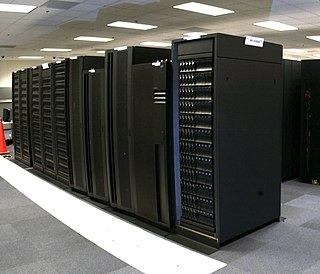
Small Computer System Interface is a set of standards for physically connecting and transferring data between computers and peripheral devices, best known for its use with storage devices such as hard disk drives. SCSI was introduced in the 1980s and has seen widespread use on servers and high-end workstations, with new SCSI standards being published as recently as SAS-4 in 2017.
Internet Small Computer Systems Interface or iSCSI is an Internet Protocol-based storage networking standard for linking data storage facilities. iSCSI provides block-level access to storage devices by carrying SCSI commands over a TCP/IP network. iSCSI facilitates data transfers over intranets and to manage storage over long distances. It can be used to transmit data over local area networks (LANs), wide area networks (WANs), or the Internet and can enable location-independent data storage and retrieval.

In computer hardware a host controller, host adapter or host bus adapter (HBA) connects a computer system bus which acts as the host system to other network and storage devices. The terms are primarily used to refer to devices for connecting SCSI, SAS, NVMe, Fibre Channel and SATA devices. Devices for connecting to FireWire, USB and other devices may also be called host controllers or host adapters.
Serial Storage Architecture (SSA) was a serial transport protocol used to attach disk drives to server computers. It was developed by IBM employee Ian Judd in 1990 to provide data redundancy for critical applications. SSA was deployed in server RAID environments, where it was capable of providing for up to 80 MB/s of data throughput, with sustained data rates as high as 60 MB/s in non-RAID mode and 35 MB/s in RAID mode.

The Symmetrix system was an EMC's enterprise storage array. It combined dozens of hard drives into a single virtual device that was then directly attached to a computer or I/O channel, or shared on a storage area network or a local area network. It was the flagship product of EMC in the 1990s and 2000s.
The HP Storageworks XP is a computer data storage disk array sold by Hewlett Packard Enterprise using Hitachi Data Systems hardware and adding their own software to it. It's based on the Hitachi Virtual Storage Platform and targeted towards enabling large scale consolidation, large database, Oracle, SAP, Exchange, and online transaction processing (OLTP) environments.
In computer storage, a logical unit number, or LUN, is a number used to identify a logical unit, which is a device addressed by the SCSI protocol or by Storage Area Network protocols that encapsulate SCSI, such as Fibre Channel or iSCSI.
A NetApp FAS is a computer storage product by NetApp running the ONTAP operating system; the terms ONTAP, AFF, ASA, FAS are often used as synonyms. "Filer" is also used as a synonym although this is not an official name. There are three types of FAS systems: Hybrid, All-Flash, and All SAN Array:
- NetApp proprietary custom-build hardware appliances with HDD or SSD drives called hybrid Fabric-Attached Storage
- NetApp proprietary custom-build hardware appliances with only SSD drives and optimized ONTAP for low latency called ALL-Flash FAS
- All SAN Array build on top of AFF platform, and provide only SAN-based data protocol connectivity.
The IBM SAN Volume Controller (SVC) is a block storage virtualization appliance that belongs to the IBM System Storage product family. SVC implements an indirection, or "virtualization", layer in a Fibre Channel storage area network (SAN).

The IBM Storage product portfolio includes disk, flash, tape, NAS storage products, storage software and services. IBM's approach is to focus on data management.

ATTO Technology, Inc. is a manufacturer of storage connectivity products for data-intensive computing. ATTO manufactures Fibre Channel and SAS/SATA host bus adapters, RAID adapters, Fibre Channel switches, protocol conversion bridges, storage controllers, MacOS iSCSI initiator software and acceleration software with storage interface connectivity to SATA, SAS, Fibre Channel, Thunderbolt devices, Ethernet and NVMe.

A storage area network (SAN) or storage network is a computer network which provides access to consolidated, block-level data storage. SANs are primarily used to access data storage devices, such as disk arrays and tape libraries from servers so that the devices appear to the operating system as direct-attached storage. A SAN typically is a dedicated network of storage devices not accessible through the local area network (LAN).
EqualLogic, Inc. was an American computer data storage company based in Nashua, New Hampshire, active from 2001 to 2007. In 2008, the company was merged into Dell Inc. Dell-branded EqualLogic products are iSCSI-based storage area network (SAN) systems. Dell has 3 different lines of SAN products: EqualLogic, Compellent and Dell PowerVault.

Universal Storage Platform (USP) was the brand name for an Hitachi Data Systems line of computer data storage disk arrays circa 2004 to 2010.
IBM Storwize systems were virtualizing RAID computer data storage systems with raw storage capacities up to 32 PB. Storwize is based on the same software as IBM SAN Volume Controller (SVC).
Adaptable Modular Storage 2000 is the brand name of Hitachi Data Systems mid-range storage platforms.
RecoverPoint is a continuous data protection product offered by Dell EMC which supports asynchronous and synchronous data replication of block-based storage. RecoverPoint was originally created by a company called Kashya, which was bought by EMC in 2006.

The Linux-IOTarget (LIO) is an open-source Small Computer System Interface (SCSI) target implementation included with the Linux kernel.
Dell EMC Unity is one of Dell EMC's mid-range storage array product lines. It was designed from the ground up as the next-generation midrange unified storage array after the EMC VNX and VNXe series, which evolved out of the EMC Clariion SAN disk array.
Dell EMC VMAX is Dell EMC’s flagship enterprise storage array product line. It evolved out of the EMC Symmetrix array, EMC’s primary storage product of 1990s and early 2000s.










